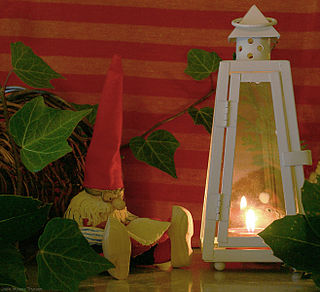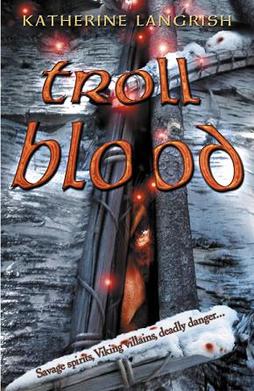
A nisse, tomte, tomtenisse, or tonttu is a mythological creature from Nordic folklore today typically associated with the winter solstice and the Christmas season. They are generally described as being short, having a long white beard, and wearing a conical or knit cap in gray, red or some other bright colour. They often have an appearance somewhat similar to that of a garden gnome.

In Norse mythology, Elli is a personification of old age who, in the Prose Edda book Gylfaginning, defeats Thor in a wrestling match.

Mjölnir is the hammer of the thunder god Thor in Norse mythology, used both as a devastating weapon and as a divine instrument to provide blessings. The hammer is attested in numerous sources, including the 11th century runic Kvinneby amulet, the Poetic Edda, a collection of eddic poetry compiled in the 13th century, and the Prose Edda, a collection of prose and poetry compiled in the 13th century. The hammer was commonly worn as a pendant during the Viking Age in the Scandinavian cultural sphere, and Thor and his hammer occur depicted on a variety of objects from the archaeological record. Today the symbol appears in a wide variety of media and is again worn as a pendant by various groups, including adherents of modern Heathenry.

Erik the Viking is a 1989 British comedy-fantasy film written and directed by Terry Jones. The film was inspired by Jones's children's book The Saga of Erik the Viking (1983), but the plot is completely different. Jones also appears in the film as King Arnulf.

Thor is a prominent god in Germanic paganism. In Norse mythology, he is a hammer-wielding god associated with lightning, thunder, storms, sacred groves and trees, strength, the protection of humankind, hallowing, and fertility. Besides Old Norse Þórr, the deity occurs in Old English as Thunor, in Old Frisian as Thuner, in Old Saxon as Thunar, and in Old High German as Donar, all ultimately stemming from the Proto-Germanic theonym *Þun(a)raz, meaning 'Thunder'.
Nordic folklore is the folklore of Denmark, Norway, Sweden, Iceland and the Faroe Islands. It has common roots with, and has been under mutual influence with, folklore in England, Germany, the Low Countries, the Baltic countries, Finland and Sápmi. Folklore is a concept encompassing expressive traditions of a particular culture or group. The peoples of Scandinavia are heterogenous, as are the oral genres and material culture that has been common in their lands. However, there are some commonalities across Scandinavian folkloric traditions, among them a common ground in elements from Norse mythology as well as Christian conceptions of the world.

Rune is an action-adventure video game developed by Human Head Studios which was released in 2000. The game is based on Ragnarok, showing the conflict between the Gods Odin and Loki and the buildup to Ragnarok. Built on the Unreal Engine, the game casts the player as Ragnar, a young Viking warrior whose mettle is tested when Loki and his evil allies plot to destroy the world and bring about Ragnarok.

Trolls are fictional monsters in the Dungeons & Dragons roleplaying game.
The Norse mythology, preserved ancient Icelandic texts such as the Poetic Edda, the Prose Edda, and other lays and sagas, was little known outside Scandinavia until the 19th century. With the widespread publication of Norse myths and legends at this time, references to the Norse gods and heroes spread into European literary culture, especially in Scandinavia, Germany, and Britain. In the later 20th century, references to Norse mythology became common in science fiction and fantasy literature, role-playing games, and eventually other cultural products such as Japanese animation. Storytelling was an important aspect of Norse mythology and centuries later, with the rediscovery of the myth, Norse mythology once again relies on the impacts of storytelling to spread its agenda.

Volstagg is a fictional character appearing in American comic books published by Marvel Comics. He is a charter member of the Warriors Three, a trio of Asgardian adventurers and supporting cast of Thor. He is known for having multiple children. These include, but are not limited to, Hilde, Rolfe, and the adopted Midgardians Kevin and Mick.
The lubber fiend, Lob, lubberkin, lurdane or Lob Lie-By-The-Fire is a legendary creature of English folklore that is similar to the "brownie" of Scotland and northern England, the "hob" of northern England and the Scottish Borders, the Slavic "domovoi" and Scandinavian "tomte". It has been related also to Robin Goodfellow, and Hobgoblins. It is best known for being mentioned by John Milton.

The Ice-Shirt is a 1990 historical novel by American author William T. Vollmann. It is the first book in a seven-book series called Seven Dreams: A Book of North American Landscapes.

Troll Mill is a children's fantasy novel written by Katherine Langrish, the second in the Troll Trilogy. It follows the events of Troll Fell, but takes place three years later.

"The Roaring Trumpet" is a fantasy novella by American writers L. Sprague de Camp and Fletcher Pratt. The initial story in their Harold Shea series, it was first published in the May 1940 issue of the fantasy pulp magazine Unknown. It first appeared in book form, together with its sequel, "The Mathematics of Magic", in the collection The Incomplete Enchanter, issued in hardcover by Henry Holt and Company in 1941, and in paperback by Pyramid Books in 1960. It has since been reprinted in various collections by numerous other publishers, including The Compleat Enchanter (1975), The Incompleat Enchanter (1979), The Complete Compleat Enchanter (1989), and The Mathematics of Magic: The Enchanter Stories of L. Sprague de Camp and Fletcher Pratt (2007). It has been translated into Dutch and Italian. In 2016, the story was shortlisted for the Retro Hugo Award for Best Novella.
The Mystical Adventures of Billy Owens is a 2008 Canadian mockbuster, which takes place in Spirit River, Alberta, about a boy who discovers on his 11th birthday that he is capable of using magic and must save his town from destruction. This film was presented in two parts under a "To Be Continued" format, with a sequel, Billy Owens and the Secret of the Runes, which followed in 2010.

Troll Blood is a children's fantasy novel, the third volume of the Troll Trilogy written by Katherine Langrish. It follows the events of Troll Fell and Troll Mill.

Katherine Langrish is a British author of fantasy for children and young adults. She was brought up in Yorkshire and Herefordshire, and wanted to be a writer from a young age. She was encouraged by her parents, and by the fact that her grandmother was a Yorkshire novelist and playwright of the 1930s, Leonora Thornber.

Magnus Chase and the Gods of Asgard is a trilogy of fantasy novels based on Norse mythology written by American author Rick Riordan and published by Disney-Hyperion. It is set in the same universe as the Camp Half-Blood Chronicles and The Kane Chronicles series. The first book, The Sword of Summer, was released on October 6, 2015. The second book, The Hammer of Thor, was released on October 4, 2016. The Ship of the Dead, the third book, was released on October 3, 2017.













